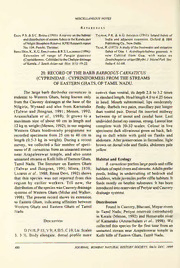
Record of the Barb Barbodus Carnaticus (Cyprinidae: Cypriniformes) from the Streams of Eastern Ghats, of Tamil Nadu PDF
Preview Record of the Barb Barbodus Carnaticus (Cyprinidae: Cypriniformes) from the Streams of Eastern Ghats, of Tamil Nadu
, MISCELLANEOUS NOTES References Easa,P.S. &S.C. Basha(1995):Asurveyonthehabitat Talwar, P.K. & A.G. Jhingran (1991): Inland fishesof anddistributionofstreamfishesintheKeralapart India and adjacent countries. Oxford & IBH ofNilgiriBiosphereReserve.KFRIResearchreport PublishingCo.,NewDelhi. No. 104,Peechi,Thrissur. Tjlak,R.(1973):Astudyofthefreshwaterandestuarine RemaDevi,K.,K.G.Emiliyamma&R.S.Lalmohan(1996): fishes ofGoa. 1. Acanthophthalmusgociensis A Extension of range of Pangio gociensis new Cobitid from Goa, with notes on (Cypriniformes:Cobitidae)totheChaliyardrainage Zenarchopterusstriga(Blyth).J. InlandFish.Soc ofKerala.J. SouthAsiannat. Hist. 3(1): 19-22. India4: 61-68. RECORD OF THE BARB BARBODUS CARNATICUS 20. (CYPRINIDAE CYPRINIFORMES) FROM THE STREAMS : OF EASTERN GHATS, OF TAMIL NADU. The large barb Barbodus carnaticus is convex than ventral; its depth 2.8 to 3.2 times endemic to Western Ghats, being known only instandardlength. Headlength4.0to4.25 times from the Cauvery drainages at the base ofthe in head. Mouth subterminal; lips moderately Nilgiris, Wynaad and also from Karnataka fleshy. Barbels two pairs, maxillary pair longer (Talwar and Jhingran, 1991; Menon, 1992; than rostral pair. Dorsal fin inserted midway Arunachalam et al., 1998). It grows to a between tip of snout and caudal base. Last maximum size of about 60 cm in length and undivideddorsalrayosseous, strong. Lateral line 12 kg in weight (Menon, 1992); in our ongoing complete with 30-32 scales. Colour in live Western Ghats biodiversity programme we specimens dark olivaceous green on back, fad- recorded specimens from 25 cm to 40 cm in ing to dull white with gold on flanks and length (0.5-3 kg in weight). During a recent abdomen. Afterpreservation in formaline, light survey, we collected a fair number of speci- brown on dorsal side and flanks, abdomen pale mens ofB. carnaticus from anunnamed stream yellow. near Arapaleeswar temple, and also some unnamedstreamsinKollihillsofEasternGhats, Habitat and Ecology Tamil Nadu. The literature on Eastern Ghats B. carnaticusprefers largepoolsandriffle (Talwar and Jhingran, 1991; Misra, 1938; habitatsofrapidriversandstreams.Adultsprefer Lazarus et al., 1988; Rema Devi, 1992) shows pools, hiding in undercutting of bedrock and that this species was not reported from this boulders, whilejuvenilespreferrifflehabitats. It region by earlier workers. Till now, the feeds mostly on benthic substrates. It has been distributionofthespecieswasCauverydrainage introducedintoreservoirsofPeriyarandCauvery systems ofWestern Ghats (Molur and Walker, drainage systems. 1998). The present record shows its extension to Eastern Ghats, indicating affinities between Distribution Western Ghats and Eastern Ghats of Tamil Found inCauvery, Bhavani, Moyarrivers Nadu. in Tamil Nadu; Periyar reservoir (introduced) in Kerala (Menon, 1992) and Hemavathi river We Description of Karnataka (Arunachalam et al., 1998). collected this species for the first time from an D IV/8;P 15;V9;A II/5; C 19;Ltr. Scales unnamed stream near Arapaleeswar temple in 5, 3 '/L Body elongate, dorsal profile more Kolli hills ofEastern Ghats, Tamil Nadu. 480 JOURNAL, BOMBAYNATURAL HISTORY SOCIETY, 96(3) DEC. 1999 MISCELLANEOUS NOTES Acknowledgements December26, 1998 M. ARUNACHALAM JOHNSON J.A. The second author (JAJ) is grateful to the Sri Paramakalyani Centrefor Council of Scientific and Industrial Research Environmental Sciences, Manonmanium (CSIR), New Delhi, for financial support. Sundaranar Univ., Alwarkurichi 627412, 77V. Refer NCES Arunachalam,M.,J.A.Johnson,S.N.Sathyanarayanappa. Misra, K.S. (1938): On a collection of fish from the A. Sankaranarayanan & R. Soranam (1998): EasternGhats. Rec. Indian Mus. XL(3): 255-264. Economically important cultivable/omamental fishes Molur, Sanjay& SallyWalker(1998): Reportofthe fromHemavathiandEkachiriversinSouthKarnataka. Workshop on ‘Conservation assessment and WorkshopreportonGermplasminventorisationandgene managementplanforfreshwaterfishesofIndia' Zoo . bankingoffreshwaterfishes,National BureauofFish Outreach Organisation. Conservation Breeding GeneticResources,Lucknow. SpecialistGroup, India. 156pp. Lazarus,R.J.,V. ArivudaiNabmi&P. SitaramiReddy RemaDevi,K.(1992):Onasmallcollectionoffishfrom (1988):Achecklistofthefishesfromthestreamsof Javadi Hills,NorthArcotdistrict,TamilNadu. Rec. JavadiHills,withnotesontheuniquecatchingmethod. Zool. Surv. India 91(3-4): 353-360. ‘Pari’.Matsya 14:47-52. Talwar,P.K. & A.G.Jhingran(1991): Inland fishesof Menon,A.G.K.(1992):Conservationoffreshwaterfishes India and adjacent countries. Oxford & IBH ofpeninsularIndia.FinalreportsubmittedtoMinistry PublishingCo. Pvt.Ltd.,NewDelhi.Vols.I&II, 1158 ofEnvironmentandForests(unpubl.).31 pp. pp. 21. RANGE EXTENSION OF OSTEOBRAMA COTIO PENINSULARIS SILAS TO KERALA The genus Osteobrama is found in the line with 55 to 60 scales; scale-rows IVi to 9/4 Oriental region and is restricted to Pakistan, between lateral line and base of pelvic fins; India, Bangladesh, MyanmarandChina(Talwar predorsal scales 21-24. andJhingran, 1991). This genus is characterised Osteobrama cotio peninsularis can be by having a dorsal fin inserted slightly behind easily identified from its closely related pelvic fins with 11 or 12 rays (8 or9 branched), subspecies by the presence of fewer branched a strong serrated spine and a long anal fin with rays in the anal fin, less than 10‘A scale-rows 14-36rays (11-13 branched). Thepresentreport between lateral line and pelvic fin, greater ofOsteobramacotiopeninsularisisbasedontwo number oflateral line scales and lesser number specimens collected from Periyar river, Central ofpre-dorsalscales. Itcanbedistinguishedfrom Kerala. O. cotio cotio in the lesser number ofbranched rays in the anal fin, less than lO’A scale-rows Osteobrama cotio peninsularis Silas between lateral line and pelvic fin; and it can also be distinguished from O. cotio cunma by Distinguishing characters: D iii-iv 8-9; the presence of greater number of lateral line A iii 28-31; PI 12-14; Vi 9. scales and fewerpre-dorsal scales. Body trapezoid and considerably Geographic distribution: Peninsular compressed, itsdepth2.2to2.9timesinstandard India: Maharashtra,Orissa,AndhraPradeshand length; abdominal edge trenchant from base of Kerala. pelvic fins to anal fin, but rounded in front of Remarks: The genus Osteobrama is pelvic fins. Mouth small; barbels absent. Dorsal represented by seven species in India, ofwhich spine weak and serrated. Scales small; lateral O. bakeri is endemic to Kerala. O. bakeri is the JOURNAL, BOMBAY NATURAL HISTORYSOCIETY, 96(3), DEC. 1999 481
